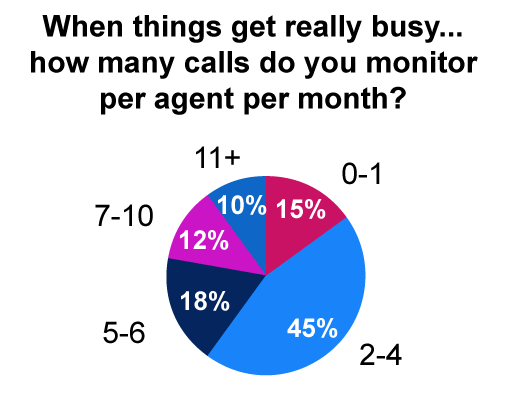In this article, we look at call centre productivity and how to calculate productivity in the contact centre – looking beyond the traditional efficiency-based definition and efficiency formula in bpo.
The Formula to Calculate Call Centre Agent Productivity
To measure agent productivity in a call centre, you can use the following formula:
Call Centre Agent Productivity = (Total Number of Resolved Calls ÷ Total Number of Handled Calls) × 100
- Total Number of Handled Calls – This is the total number of calls that an agent or the call centre as a whole has managed, regardless of the outcome. It includes all customer interactions, whether they resulted in a resolution or not.
- Total Number of Resolved Calls – This represents the number of calls that were successfully resolved by the agent. A resolved call typically means that the customer’s issue was fully addressed during the interaction, leading to a satisfactory outcome without the need for further follow-up.
Put another way to calculate call centre agent productivity you need to divide the total number of resolved calls by the total number of handled calls. Then multiply the resulting ratio by 100 to convert it into a percentage.
This percentage gives you a clear, high-level view of the call center’s productivity in terms of issue resolution.
Example Productivity Calculation
Imagine your call centre handled 1,000 calls in a week, and 850 of those were resolved satisfactorily, your formula would look like this
Call Centre Agent Productivity = (850 ÷ 100) × 100 = 85%
In this scenario, the productivity rate is 85%, meaning that 85% of the handled calls were successfully resolved. This figure provides a snapshot of how well your agents are performing in terms of delivering resolutions to customer issues.
Don’t Use the Factory Definition of Productivity
Too often people try to apply factory logic to contact centre productivity, by trying to measure calls per hour or by finding a percentage for occupancy. Yet, these calculations are based on staffing levels and your service level objectives – not how hard advisors are working.
In his article One Myth of Contact Centre Productivity, Daniel Ord, the Founder and Director of OmniTouch International, says the following:
“In Service level-based environments, contacts such as calls, live chats and walk-ins arrive randomly.
So, at any point in time, your Team Members are either engaged in handling a contact or are waiting for a new contact to arrive.
The Call Centre Productivity Formula with Example
Occupancy Rate + Available Rate = 100% for Any Period of Time

If your Agent is 85% occupied for any given period that means, by default, they are experiencing a 15% available rate over the same period.
Let’s do the math using an hour as time basis:
- 85% Occupancy x 60 minutes = 51 minutes
- 5% Available x 60 minutes = 9 minutes
But those 9 minutes – spread over the course of an hour – come in bits and bursts.
5 seconds here…42 seconds there…1 minute here and so on.
Does it really make sense to ask your Agents to try and handle other contacts at the same time during these fits & bursts of Available Time?”
A contact centre is not a factory, so productivity cannot be measured by efficiency.
Jonty Pearce, Editor of Call Centre Helper
No, that is the simple answer. An advisor’s “available rate” is dependent on call patterns and how well the contact centre is staffed, it is not a valid indicator of how well they are working.
So, to measure advisor productivity, contact centres must look to use a set of metrics that does not include occupancy or calls per hour/day/week.
The Right Way to Measure Call Centre Agent Productivity
Daniel Ord stresses that the weighting and formula of the following set of metrics will change, given the priorities of different contact centres, he said that typically there is a basket for productivity, at the advisor level, that comprises of:
- Adherence to schedule – this is always the ‘biggest’ ingredient – when advisors adhere, service level stabilises and that’s what matters. This is a metric that advisors have a high degree of control over.
- Some level of Average Handling Time (AHT) – this should not have a high weighting (0-15% maybe) on the overall productivity score, but this is something that some managers still want to include, just to let the team know that it’s something they look at.
- Some people like to break out auxiliary (AUX) time separately – no problem, but just remember AUX is nothing but a subset of Adherence to Schedule – so it’s a business decision, if you need to break it out.
- Some service level – you can’t target an advisor against service level performance, as they don’t control service level. But, some contact centres base 5-8% of their overall productivity measure on service level because when service level works life is good and when service level doesn’t work life is not so good. So, it’s a “we’re all in the same boat” type measure.
The weighting of each of these four elements in productivity calculations would vary somewhat depending on the industry and nature of contacts handled.
When we asked Daniel for general weightings, for a customer service-based contact centre (without regard for industry type), he suggested:
- 80% – Schedule Adherence
- 10% – Some level of AHT
- 5% – AUX time
- 5% – Service level
Taking this information, out of industry context, you can use the following equation to measure productivity, at an advisor level:
Productivity = 0.8 (Schedule Adherence) + 0.1 (AHT) + 0.05 (AUX Time) + 0.05 (Service Level)
Daniel adds that: “This is the correct approach to measuring advisor productivity for phone calls, face to face, video chat – any Service Level based contact. That’s an important caveat.”
“This also applies to live chat, with the understanding that some folks don’t incorporate the number of concurrent chats being handled, but that can be figured out.”
The Wrong Way to Measure Productivity
There are many metrics that some contact centres use in their advisor productivity calculations that may offer a false representation of how hard individual team members are working.
The three common metric mistakes that contact centres make are:
1. Including the Number of Contacts Handled Over a Certain Time Period
Never do this for service level-based contacts. Many people within the industry don’t know the difference between service level and response time.
2. Occupancy
This metric is an important metric for management, because it gives them a percentage for how much of their resources are being used. But, it is not a great measure of productivity.
Why? Because if you want to maintain a good service level, you need to keep some advisors in “reserve” to handle random contact arrival patterns.
Also, you need to keep occupancy under 85%/90%, if you want to avoid advisor burnout.
In addition, occupancy highlights the advisor experience. No, you can’t target it, but you must know it, budget and plan around it at senior level. However, this is a complex high-level function, which few do correctly.
3. 100% (or a Large Percent) AHT
If advisors are targeted on AHT, as an indicator of their productivity, it is likely that they will begin to rush through calls. This takes away from their ability to listen properly and it can also drive other negative behaviours.
Dave Appleby, a Resource Planning Expert, also takes issue with using the three metrics about as a productivity measure.
In fact, when contact centres do this, Dave says: “Supervisors can be seen as draconian rule enforcers whose only job is to make staff work as hard as possible. This often results in management pressuring teams on productivity.”

Dave Appleby
“Senior Management come down on the Team Managers, the Team Managers will in turn come down on the Supervisors, forcing Supervisors to target Advisors on efficiency. This sends a message to staff that they’re not working hard enough (even if they are).”
“The next thing that happens is attrition goes through the roof. You’ve got a sweatshop reputation that will be hard to shake and a recruitment problem for the same reasons.”
Don’t Confuse Efficiency and Productivity
Contact centre productivity and efficiency tend to be used interchangeably at Senor Levels. But, they are very different metrics.
Productivity is based on the levels of output, whereas efficiency is more about reducing waste.
It’s alright to say that you want to run an efficient contact centre, you just need to define what that looks like.
Effectiveness = Productivity + Quality
While call centre productivity measures can be good, it is important to also measure quality. This is because contact centre and BPO effectiveness is generally made up of 50% productivity and 50% quality.
However, quality is not part of productivity and the two measures should be kept separate from one another. As Daniel Ord says: “The decision on how to ‘mix’ the basket of productivity or quality standards is dependent on the type of organisation and its purpose.”

Daniel Ord
“For example, a cost-efficient focused organisation may choose to weight AHT more heavily. That doesn’t mean they are right or wrong – it’ s reflection of a cost-control mentality. They may tell you that 25% of the agent productivity score is based on AHT.”
“On the other hand, a very customer experience focused company may tell you that they don’t put in any AHT measure on agents as they want agents to do what is necessary to deliver a great experience. They might tell you 0% of the agent productivity score is based on AHT.”
However, when it comes to quality, quality scores shouldn’t be used in isolation. Voice of the Customer (VoC) feedback should also be included in quality calculations. This is important, especially as we found that most contact centres measure four or fewer calls per advisor, every month – as highlighted below.

This poll has been sourced from our page: In Busy Periods, 45% of Contact Centres Monitor 2-4 Call Per Agent
So, an advisor’s quality scores should be based on more than a handful of interactions, as scores may only reflect luck of the draw.
Also, when you are measuring quality beyond the advisor level, customer feedback can also indicate what is productivity in BPO is as a whole, i.e. how effective your processes and technology are.
An advisor can do everything right during a contact centre interaction, but poor self-service design, for example, can let the contact centre down later in the customer journey.
Remember, productivity does not start and end with advisors. It is up to management to provide them with the right tools to do the job and try to make the customer journey as smooth as possible. Customer journey mapping is a useful tool for doing this.
What to Watch Out for When Measuring Productivity
When we asked our readers and other industry experts for their thoughts on this topic, and some of them replied with useful tips which should be considered when measuring productivity in the contact centre.
Here are three tips which will help you to avoid the pitfalls calculating productivity.
Shrinkage Should Not Be Included in Productivity Calculations
If shrinkage activities are included in efficiency measures (your occupancy and calls answered metrics), the calculations will indicate that the team are being a lot less productive than they actually are.
To be clear, shrinkage includes any scheduled/unscheduled contact centre activities that take advisors away from the phone. This means that shrinkage can include holidays, absence and lateness, as well as coaching, team meetings and one-to-one time.

Nerys Corfield
So, shrinkage should be removed from productivity calculations altogether. As Nerys Corfield, the Director of Injection Consulting, says: “The determination of what is productive should be broader than just talk and wrap, as who would classify training or coaching as a waste of time/unproductive?”
Nerys also stresses the importance of measuring both efficiency and effectiveness, to calculate productivity.
She says: “Efficient and effective should not be mutually exclusive, but, with efficient being a metric that is easier to measure, it’s common to just look at the advisor activity and separately look at indicators which flag training needs.”
Don’t Add Complex Metrics Straight Away – Make Sure the Team Can Understand Your Measures
Paul, one of our readers, suggests measuring productivity by “starting with the basic KPIs (Key Performance Indicators) in relation to productivity, all of which are within a controlled environment.”
“Once you have the basic principles in place, start adding additional metrics like conversion rates, customer verbatim, Calls Per Hour, etc.”
But Paul also stresses that it is important to “ensure the staff embrace the rationale behind the metrics and get a commitment from all involved.”
This is important, because if the team believe that their productivity is being measured simply through efficiency, they could rush through calls or even, in extreme cases, play tricks to end calls quickly.
These tricks could include advisors pretending not to hear the caller, so the customer hangs up and calls back. The customer then gets put through to a different advisor and the “trick playing” advisor gets sent to the “back on the pack”, having already “handled” their call.
To find out what other tricks your advisors might be playing, read our article: 7 Tricks That Call Centre Employees Play
Accurate Forecasting Improves Productivity
At a management/Workforce Management (WFM) level, you can’t understate the importance of accurate forecasting.
There are great industry standards that are related to the levels of accuracy of forecasting.
Great forecasting = the first level of efficiency in the contact centre.
Reducing Repeat Contacts = Great Source of Efficiency
Another great source of efficiency is to eliminate unnecessary repeat contacts. That is the power of First Contact Resolution (FCR).
By looking at root causes and fixing them, you can reduce repeat contacts and consequently boost FCR.
Eliminate these repeat contacts is an excellent source of efficiency and is arguably best summed up by the title of Bill Price and David Jaffe’s 2008 book: “The Best Service is No Service”.
Summary
To gain a good view of your contact centre’s productivity, it is important to avoid measures that are based on call arrival, such as calls per hour/day/week and occupancy, and focus on metrics that advisors have some control over.
So, contact centres should have a group of metrics to measure productivity, but schedule adherence should be given the greatest weighting.
Yet, it is also important to remember that productivity doesn’t equal effectiveness – quality must also be considered when evaluating effectiveness. Not just quality scores though, quality scores mixed with VoC feedback.
For more insights from Daniel regarding contact centre productivity, read our article: 4 Customer Service Objectives That Will Improve Productivity and Customer Experience
Find out how to calculate more contact centre metrics, by reading any of the articles below:
- How to Measure Employee Engagement
- How to Calculate Attrition Rate – The Formula
- How to Measure Average Handling Time (AHT)
Author: Charlie Mitchell
Reviewed by: Jonty Pearce
Published On: 13th Jun 2018 - Last modified: 22nd Aug 2024
Read more about - Customer Service Strategy, Charlie Mitchell, Daniel Ord, Dave Appleby, Editor's Picks, How to Calculate, Metrics, Nerys Corfield, Occupancy, Performance Management, Productivity





































